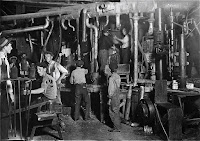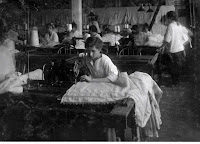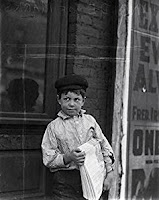 |
| Group of Breaker Boys (1911 January) |
Industrial Revolution
The
times of Industrial Revolution which was a period between 18th and 19th
centuries defines an industrial progress in Europe and America. It brought
about a quick change in the social statutes and lifestyles of some parties in
society. While Industrial Revolution has been leading to a decrease in
agricultural activities and rural depopulation, as a result of this, it created
an urban and industrial life style which put the poor community in a
detrimental situation.
 |
| Children Working on Handloom |
Generally the term of poor community is used for a
collective group of people who are meant to survive because of poverty. But in
this case, the term is specifically defined as children of poor parents who
works for peanuts and orphans in society. Child labour of the Industrial Revolution
is a case which has to be considered from the angles of human right violations,
the Universal Declaration of Human Rights, economical convention and social
rights.
 |
| Child Factory Workers |
The
child labour of Industrial Revolution refers to a group of children which were
in the ages of six to fourteen in variety. Those children were responsible for
using dangerous equipments in factories for long working hours even up to
nineteen hours in a day.
Punishment Methods
 |
| Child Labor Doffer Boy (1909) |
When working conditions of factories checked for last
period of the 19th century, it can be seen that the children workers had
burdened with several types of cruel duties and faced with verbal abusing every
day from their chiefs. Those chiefs were grown textile workers who had the
managing rights on children in order to make production faster. But they were
taking no responsibility for the needs of children such as safety and
nourishment. Some punishment methods also existed during this period to keep
the child labour in an order such as weightining and lack of clothing.
 |
5 Years Old Manuel
Shrimp Picker |
Weightining is
a punishment method imposed for being late at work or not performing well in
work hours. The child who had this kind of penalty was called weighted.
Generally, a watcher was detecting the child who was late or running out the
clock, then he was tying a heavy object to the child’s neck and forcing him to
roam in the factory or walk the stair up and down around an hour. The main
purpose of this charging was discouraging other children to lounge or be late.
Weighting was causing many neck and tissue injuries.
 |
| 15 Years Old Gertrude Belier |
Another punishment method
was lack of clothing which can also be seen as a precaution rather than a punishment
from the tycoon’s point of view. For only boys, putting their clothes to the factory in the middle of the night, was making them punctual to
catch working time up. Besides punishments, there were some other unhealthy
conditions in factories. To be specific, workers of a match factory were drawing
a chemical element phosphorus into their lung. As a result of this, many diseases
have been occurred such as mouth sores, dental caries and even lung cancers
which end by death desperately. Similarly, child labour who was working in coal
mines used to have bodily harms because of carrying coal bags on their backs,
digging open doors under mine and pulling coal carts.
According to the Human Right Norms
 |
| 12 Years Old Giles Newsom (1912) |
Conversely the prescribed
industrial diseases, the children worked in mills were usually getting harmed
by overworking. However, there exist some cases of children who felt asleep on
a working machine and had scalp wounds caused by that their hairs had been
caught by a machine. All in all, when we checked these detrimental conditions
to work for a child, it must be said that many human right norms were violated
such as having the right of life, security and bodily integrity, the right of
healthy, viable and supportive environment, the right of justice, equality and
non discrimination in environment matters, lastly the right of a social and
international order in which all human rights may be fully realized.
 |
| Child Oyster Shuckers (1912) |
 |
| A Child Worker in 1920s |
The Universal Declaration of Human Rights is an agreement which is also a part of
United Kingdom laws, has the importance of being first declaration contains
basic descriptions of human rights. While this declaration which includes the
principles of civil rights just like the Covenant on Civil and Political Rights
does as well, it is expected that, the covenant should had touched on the
delicate issue of children rights specifically. But it could not, therefore, a
lack of rights for child labour remained until the date of 1989 which was a
year that ‘Convention the Rights of the Child’ was signed. This agreement
fulfilled the demand for children rights.
Economic Aspects
 |
| Young Mill Workers (1908) |
 |
| Child Coal Miner (1909) |
To
light up the issue economically, it is necessary to understand controversial
claims revealed by tycoons of the period in order to fend the blaming off. In
this case, ‘Covenant on Economic, Social and Cultural Rights’ says that
improving the methods of production by using the technical and scientific
knowledge by developing agrarian system in order to archive a most efficient
development is acceptable in article eleven. On the other side, article seven
mentions about the necessities of fair wages, safe and healthy conditions,
resting and leisure hours respectively.
 |
| The Lowell Mill Girls |
One of the main arguments comes from
tycoons who were forced to produce more in a competitive environment is giving
the opportunity of sheltering and nourishment to the children workers, orphans
especially in return for their effort in work. It seems that; this kind of
arguments were used for long to overlap the bad working conditions existed during the Industrial Revolution. Then it turned this fatality
to moral actions in the eyes of public. So, it is disclosed that the economical
approach of the Industrial Revolution had negatively made the poor community
focused on gains of that period instead of realizing what’s hiding behind these
achievements.
 |
Sadie Pfeifer
Cotton Mill Spinner (1908) |
 |
| A Child Worker in 1910s |
For
today’s world, the major solutions detailed by declarations for the protection
of child labour from the dangerous situations were already revealed above. In
addition to those, making the Covenant on Economical, Social and CulturalRights compound with the ‘Covenant on the Rights of the Child’ can be another
precaution to avoid conflicts in these declarations which were open to interpretation.
Summery
 |
Sadie Pfeifer
Cotton Mill Spinner (1908) |
To
conclude, one of the major human right violations in history, concerning the
child labour during the Industrial Revolution is revealed due to the laws of that
period and today, economy and the declarations on child rights. The industrial
accidents and terrible working conditions were also mentioned in
respect to the real-life examples on the topic which is the most significant
case in the history of human rights, also needs to be held priority to avoid
same kind of violations in the modern world.
Lewis Hine, Creator of Photographs Above
 |
| Lewis Hine |
Let’s make an end to this article
with the famous words of Lewis Hine who was the creator of all these photographs remained as today. "There is work that profits children,
and there is work that brings profit only to employers. The object of employing
children is not to train them, but to get high profits from their work." Lewis
Hine, 1908.
















 Reviewed by Articonog
on
December 19, 2019
Rating:
Reviewed by Articonog
on
December 19, 2019
Rating:
 Reviewed by Articonog
on
December 19, 2019
Rating:
Reviewed by Articonog
on
December 19, 2019
Rating:





No comments: